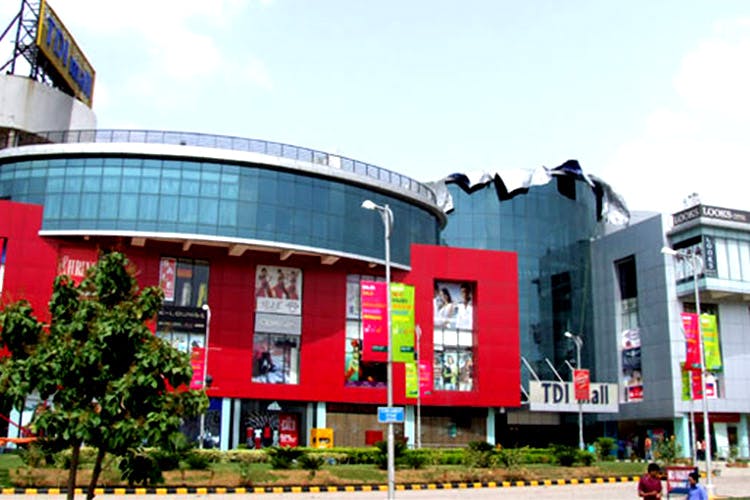There is a singular concentration of boys called Bunty, and that’s all the concentration they’ve ever done. The Aztec prints are replaced with rhinestones, the alloy wheels with neon lights, and there is paneer in everything. The streets are witness to a lot more spitting and the cowering rage of people constantly asking each other if they know who their fathers are. Somewhere on the Ring Road after Dhaula Kuan and before the meandering madness of Pitampura, you cross the threshold to another realm, surreal and magical: The Chronicles of Naraina, ladies and gentlemen.
But every city has its premier neighbourhoods, and so the socio-economic differences that exist within cities aren’t unique to Delhi, and nor are the identifiers of these differences unique- music, fashion, dialect, and choice of pet’s name. What is unique, however, is that around the time that kitty parties and our collective afternoons were making the leap from samosas to mimosas, the stereotypes and generalisations that we used to segregate South Delhi from the rest of the city wrongly came to be accepted as verifiable facts. Emanating first from class consciousness of the upwardly mobile, then from megalomania and finally from abject elitism, somewhere down the road being from certain other parts of Delhi became a slur.
I was born in West Delhi, and lived there most of my life. When I was 13, I dismantled my mother’s immaculately-assembled family album, and thanks to the dates on the back of each photo and some rudimentary mathematics, I calculated that I was also conceived in West Delhi. I can therefore, confirm with some authority that no, Rajouri Garden is not a substitute for mall-hopping in Saket. And yes, while you might find a better and thriftier mojari in Karol Bagh, you’d have to be an idiot of Congress-Prime-Ministerial-Candidate proportions to believe that you’d be better off shopping there in general – but you already knew that.
There’s more to a place than its inability to be your premier destination for retail therapy, and this is truer in Delhi than anywhere else. Delhi is myriad versions of a million stories. It’s not made up of any one kind of people, nor defined by one eloquent and prosperous demographic. The city is fluid, multicultural, oscillating from hauntingly beautiful to disturbingly drab, from terrifyingly archaic to impressively progressive, from rumbling towards revolution to back to apathetic, from Jagjit Singh to Honey Singh to embarrassing.
Sure, parts of it – yes, like West Delhi – are a bit louder, and sometimes look like their general colour palette was meticulously handpicked by Anne Frank, but they still represent the city every bit as the turgid affluence of the south or the confusing roundabouts of Lutyens and the scholastic aspirations of the North. At over sixteen million people, Delhi has more residents than Ireland, Croatia, New Zealand, and Qatar combined. We’re a migrant hub, sheltering and birthing sub-cultures for decades, and proving literal and figurative refuge to millions cast aside by historical turmoil. It’s no surprise then that decades later, from one street corner to the next, languages and loyalties still change.
In the ridiculed parts of Delhi like the one I live in, there is a Resident Welfare Associations that still lets kids play in the parks, and arguably the best chaat I’ve ever come across {and I’m a bit of a chaat connoisseur}. Sure, maybe the south has all the good restaurants {and the jingoism}, but it also has parking for a total of about seventeen cars. It all evens out: There’s a Madipur for every Zamrudpur, a Punjabi Bagh for every Panchsheel.
Delhi’s best neighbourhood would probably involve statistical analysis factoring in a qualitative index of the cost of living, schools in the vicinity, connectivity, creative capital, safety, restaurants and nightlife – analysis that I’m incapable of since my usefulness with a calculator ends at writing 55318008, turning it upside down and snickering. Until someone with more patience and maturity accomplishes this, we’re resigned to calling each other names and watching Colossal Kajal-ed eyes widen in surprise as newspapers tell us about prices per square yard.
I believe we could do without that information.
There’s a little bit of Delhi’s multifariousness in all of us, and that’s why you might find us at the wedding at that farm, mouthing the words to Brown Rang either with aplomb or feigned reluctance, with a glass precariously balanced atop our heads, or at that new place that has that lovely cocktail and plays the best electroindietranspopdubchill, or at the house party at one of our friends’ friend’s place, the one that lasted all night. We might cross paths when you’re huddled around that vendour with the good momo and exceptional chilli sauce, wondering why you don’t do this more often, or in the parking lot as we pregame in the car. This is our city: All iterations of it. I’ll see you around.
I’ll be easy to spot: I’m from West Delhi. I look like a criminal who borrowed clothes from Govinda’s wardrobe.

